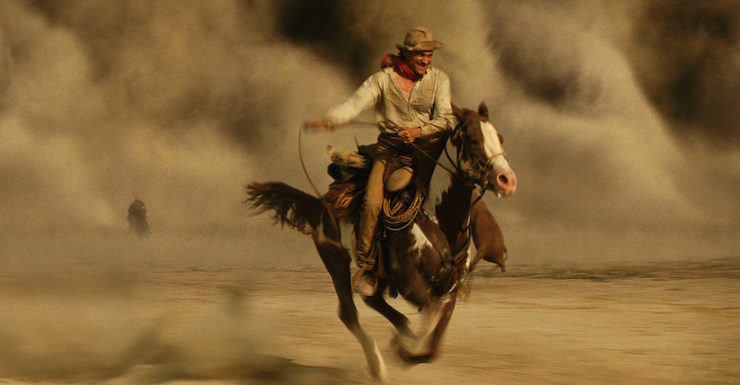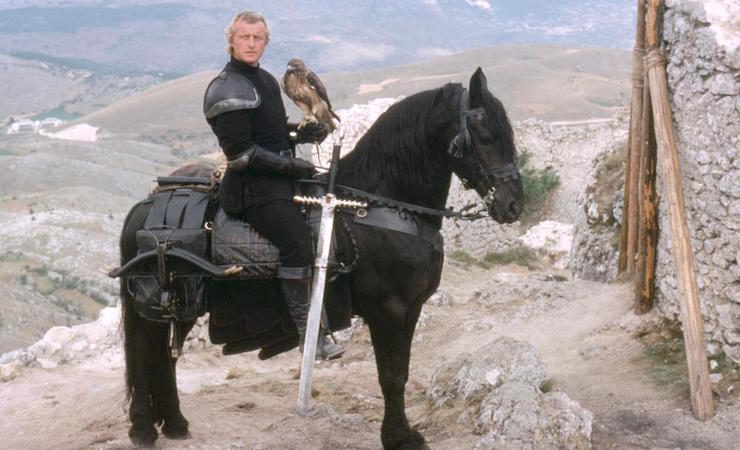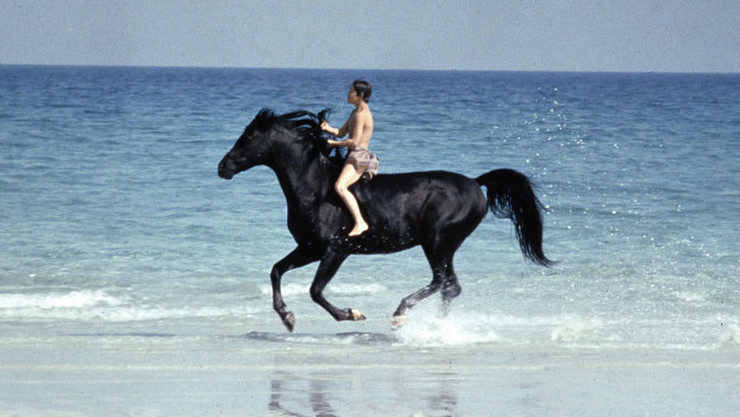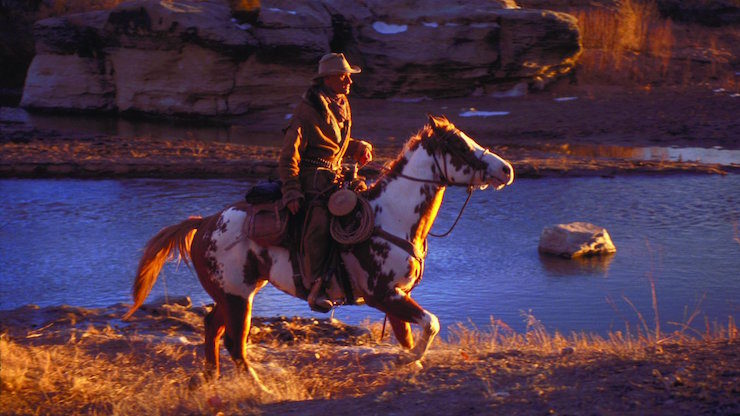To the non-horse person, a horse is pretty much just a horse. There’s the really big one like the beer-wagon Clydesdale and the really little one like the Mini doing therapy at the hospital. Then there’s the one that races and the cowboy one. And the wild one. The rest are black, brown, white, or spotted, and sort of blur together.
Which is how I sometimes think movie people pick their horse actors. I know it has more to do with what the wranglers and trainers have available than with straight-out lack of knowledge, but sometimes I do wonder.
Film being a visual medium means looks count for a lot, and not just with the human stars. The animals have to look good, too, even if that means a glossy, well-fed, shiningly clean, perfectly groomed to show standard grey horse allegedly belonging to an impoverished family. Humane regulations require that the animals in a film be well fed and treated, but a plainer animal and a little cosmetic dirt would be more authentic in the context.
That’s fairly minor in film terms—the human actors tend to be spit-shined and too impeccably groomed, too. What catches horse people up short in films with horses in them are horses that aren’t actually suited to the jobs they’re shown as doing, and horse breeds that did not exist in period, and wee delights like stirrups in Roman epics (no stirrups till after Rome fell—like, age of Charlemagne in the West). And there’s also my personal peeve, the wrangler who taught Every Single Actor In Or Out Of Hollywood to leap on his horse and yell, “Hyaah!” to make the horse go.
I tried that once. The horse looked at me like, You done screeching, monkey? Can we go now?
That’s right up there with Every Single Coach And Stage Driver Everywhere slapping the reins to make the team go. No. No no no. Not done. This is probably where all those fantasy novels got “He shook the reins to make the horse he’s riding go,” too. Also very no.
One horse breed is just about Everywhere in fantasy and medieval films. That’s the big black one with the flowing hair. It’s a breed, and a somewhat rare one, and it’s called the Friesian.
Friesians are downright gorgeous, and they tend to have a lovely temperament. Proud but kind. Tolerant of human foibles. They’re flashy movers, too, with lots of knee action to get the hair flowing. As I said, lovely.
The first one I noticed in a film, as did every other horse person with access to modern technology, was Navarre’s mount in Ladyhawke. His name was Goliath, and he was a big boy; when we were done fangirling over him, we sighed over the beauty of the young Rutger Hauer.
Apparently the actor and the horse bonded. They certainly had chemistry on screen. And oh, the eye candy!
Thing is, if this is supposed to be a medieval setting, there wouldn’t have been any Friesians. Friesians were bred in much later times to pull funeral coaches in Flanders. Hence the glossy black coats, the high knee action and the flashing trot which can be hard to sit, and the overall build and mass, which are more suited to a coach or draft horse than a riding horse.
Somewhat more accurate would be the white horses with the flowing hair who also appear in the film. Those are Iberians, horses of Spain and Portugal, and they were known in the time of El Cid, having come down from the Roman era. Note the smaller height, the lighter build, and the lack of feathering on the legs. Those are horses bred to ride.
Now mind, the great horse or destrier of the medieval knight was pretty much a draft horse. The Shire horse of England according to legend was bred under King John for knightly use, and the Percheron of France descends from the destrier as well. They’re both still with us, and still excelling in any activity that requires pulling. Crossed on lighter breeds, they’re popular as field hunters, jumpers, and all-around riding horses.
The knights’ destriers were incredibly valuable animals, often worth more than the knight’s entire demesne, between their breeding and their training, and they were not casual riding horses. When they were not being ridden in the charges or in jousts, they were led; the knight would want to save his horse’s strength for the fight, and not wear him out riding him to it.
Because, you see, big, heavy horses are not big on stamina. It’s a terrible idea to take a Draft horse to an endurance race. They function best in short bursts that use their weight to advantage: charging an enemy line, pulling a log out of the woods.
Friesians have actually been studied, and their cardiovascular systems are not quite enough for the bulk of their bodies. As a trainer told me once, “Their hearts and lungs can’t keep up. They don’t have any stamina.”
Of course Ladyhawke is a fantasy. It’s not set in a real medieval world, so it can use whatever horses it wants. But by sticking with his beloved Goliath in his wanderings, Navarre has set himself some challenges. The horse can’t travel far per day especially in hot weather. He eats a lot. A Lot. Grooming is a constant process—all that hair tangles, and needs regular maintenance. And keeping his coat from fading in the sun takes work as well.
In my head canon, the two are so devoted they can’t be parted, and Navarre can’t afford a second horse in any case, even if he wanted to keep one for Isabeau in case they ever revert to permanent human form. So the destrier becomes the daily mount, and being who he is, which means he’s as sweet as the day is long and he loves his rider to death and beyond, he does the very best he can. And Navarre nurses him along and pampers him and watches over him.
Having Mouse along to help is a big relief. Poor man, he’s got as much as he can handle, what with the Lady Hawk and the evil bishop and the general mess his world is in. And then he has to spend every night running as a wolf. He never gets any sleep.
I’m good with Goliath in this film. It’s all gorgeous people and animals doing grand fantasy things. But it started a trend, not always to best effect. Jaime Lannister riding north on that nice Friesian is a pretty image with lots of symbolism, but that’s not a horse I’d pick to ride a thousand miles in the dead of winter. Cold tolerance he’s got, but a hard keeper without much stamina is a poor choice for the job. Jaime’s not going to be able to change him out at posting stations, either, if he’s riding incognito.
If I were his master of horse I’d find a sibling of that dear loyal white horse Jaime lost to dragon fire. He looks as if he has some desert blood in there, ergo stamina, and he’s probably a fairly easy keeper. He can go the distance.
Shifting to the other end of the gorgeous black horse spectrum, there’s the Black in The Black Stallion, played in the film by Cass Ole and an assortment of body doubles. Here’s stamina to burn: the Black is an Arabian, also known as the endurance mount. If you want a horse who can go 100 miles in under 16 hours and finish with energy to spare, that’s an Arabian.
They go easy on the feed, too. They’re not heavy enough to carry a knight in full armor, but they’ll get him to the battle (with his armor packed on a sumpter mule) and they’ll take him on the long chase after to round up stragglers. They can run rings around the heavy destriers—as the armies of Islam did in battle after battle to the Crusaders—and thrive on an amount of feed that would barely keep the destrier alive.
The Black is pure fantasy, but parts of his story are surprisingly realistic; kids have been sneaking rides on horses sans tack for millennia. What’s not real is the idea of an Arabian entering Thoroughbred races. That doesn’t happen. There are Arabian racing circuits, and there may be exhibition races, but Thoroughbreds race with each other—purebred horses from specific bloodlines, registered with the Jockey Club. They are descended from Arabians, but they’ve long been their own breed. No outsiders can apply.
There’s also the fact that Arabians and Thoroughbreds are two different kinds of runners. Thoroughbreds are milers—middle-distance runners. The Quarter Horse, who is a sprinter, will leave them in his dust at the quarter-mile, but the Thoroughbred rules the mile.
The Arabian at that distance is still getting started. He won’t match the speed of the Thorougbred in the shorter distance, but as the race gets longer, the miler poops out and the Arabian is still going. He’s the marathon runner of the horse world. Horse people know that training methods designed to tire out a Quarter Horse will give you a very fit Arabian. He’s not going to stop; he’ll go and go.
And that brings me to one of the biggest examples of facepalm casting I know of. Hidalgo is allegedly based on a true story, but let’s just say the guy who told it was working in the grand tradition of the American tall tale. It’s about a horse from the Wild West who was entered in an allegedly famous race across Arabia. (The race never existed. The horse maybe did, but his owner/promoter was more than a little bit free with the truth.)
The horse in the story was a Mustang, and the original star of the film, as in the legend, was a Spanish Mustang. But he was unable to participate, and was replaced by a small herd of American Paint Horses.
Mustangs, descended from Spanish horses brought to the Americas by the Conquistadores, are feral horses. They’re small, tough, smart, and have tons of stamina. Paints are a modern breed. They’re supposed to be lavishly spotted, as the horse in the film is, and their ancestry is primarily Quarter Horse and Thoroughbred. In the case of the horse in the film, by body type, mostly Quarter Horse, and modern Quarter Horse at that.
A sprinter. In a film about a marathon to end all marathons. In which the star runs against Arabians.
Nope. Nope nope.
The horse who gets the most air time is adorable, in fact they all are. Viggo Mortensen was so taken with one of them that he bought the horse—Viggo is a real horse person; he tends to fall in love with his movie partners. He bought Brego from LOTR, too.
But these are not endurance horses. Quite apart from the fact that there never was any such race, that lovely chunky spotty boy would not have been a contender. That’s not what he’s made for. He’s designed to run short sprints, and to stand up in a show ring and be judged for his very particular conformation and his spectacular coloring. He’s an artifact of the late twentieth and early twenty-first centuries, and bears little resemblance to the horses of the period in which the film is set.
An actual Mustang might have managed. Mustangs have the stamina, the smarts, and the feet (feet are a huge issue with the Quarter-Horse-based breeds, to the point that many have serious problems functioning). They might not win on speed, but they’ll hold the line on sheer cussedness and refusal to quit.
Since the film aired, a collection of adventurous horse people have put together their own very long endurance race—but in Mongolia. The Mongol Derby needs its own film, it really does. It sends a couple of dozen very, very fit riders to Mongolia, mounts them on Mongol horses from herds kept for the purpose, and lets them rip on routes taken by the post-riders of Genghis Khan. The horses, like Mustangs, are small, sturdy, tough, and massively opinionated. Riders change horses every day, for the health and safety of the horses—the riders have medical staff following them, but they have to make it through the whole race. The horses get to rest after their stages.
Now that’s a race, and it really happens every year. The riders are indomitable and the horses test them in every possible way. Real riders, real horses, but doing something straight out of a fantasy novel.
Judith Tarr is a lifelong horse person. She supports her habit by writing works of fantasy and science fiction as well as historical novels, many of which have been published as ebooks by Book View Cafe. Her most recent short novel, Dragons in the Earth, features a herd of magical horses, and her space opera, Forgotten Suns, features both terrestrial horses and an alien horselike species (and space whales!). She lives near Tucson, Arizona with a herd of Lipizzans, a clowder of cats, and a blue-eyed dog.













